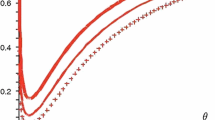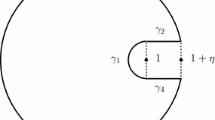Abstract
Assume that there is a random number K of positive integer random variables S1, …, SK that are conditionally independent given K and all have identical distributions. A random integer partition N = S1 + S2 + … + SK arises, and we denote by PN the conditional distribution of this partition for a fixed value of N. We prove that the distributions {PN} ∞N=1 form a partition structure in the sense of Kingman if and only if they are governed by the Ewens-Pitman Formula. The latter generalizes the celebrated Ewens sampling formula, which has numerous applications in pure and applied mathematics. The distributions of the random variables K and Sj belong to a family of integer distributions with two real parameters, which we call quasi-binomial. Hence every Ewens-Pitman distribution arises as a result of a two-stage random procedure based on this simple class of integer distributions. Bibliography: 25 titles.
Similar content being viewed by others
References
A. M. Vershik and S. V. Kerov, “Locally semisimple algebras. Combinatorial theory and the K 0-functor,” J. Sov. Math., 38, 1701–1733 (1987).
S. V. Kerov, “Subordinators, and permutations acting with quasi-invariant measure,” Zap. Nauchn. Semin. POMI, 23, 181–218 (1995).
S. V. Kerov, “Small cycles of big permutations,” PDMI Preprint, 22/1995 (1995).
S. V. Kerov and N. V. Tsilevich, “Stick breaking process generates virtual permutations with Ewens distribution,” Zap. Nauchn. Semin. POMI, 23, 162–180 (1995).
V. F. Kolchin, “A certain problem of the distribution of particles in cells, and cycles of random permutations,” Teor. Veroyatn. Primen., 16, 67–82 (1971).
V. F. Kolchin, B. A. Sevast’yanov, and V. P. Chistyakov, Random Allocations, Wiley, New York (1978).
I. G. Macdonald, Symmetric Functions and Hall Polynomials. Clarendon Press, Oxford (1995).
W. J. Ewens, “The sampling theory of selectively neutral allels,” Theoret. Population Biol., 3, 87–112 (1972).
W. J. Ewens, “Population genetics theory-the past and the future,” in: Mathematical and Statistical Developments of Evolutionary Theory, S. Lessard (ed.), Kluwer, Dordrecht (1990), pp. 177–227.
P. R. Halmos, “Random alms,” Ann. Math. Stat., 15, 182–189 (1944).
S. Kerov, G. Olshanski, and A. Vershik, “Harmonic analysis on the infinite symmetric group,” C. R. Acad. Sci. Paris, 316, 773–778 (1993).
S. V. Kerov and A. M. Vershik, “The Grothendieck group of the in.nite symmetric group and symmetric functions with the elements of the K 0-functor theory of AF-algebras,” in: Representation of Lie Groups and Related Topics. Adv. Stud. Contemp. Math., 7, Gordon and Breach (1990), pp. 36–114.
J. F. C. Kingman, “The representation of partition structures,” J. London Math. Soc. (2), 18, 374–380 (1978).
J. F. C. Kingman, “Random partitions in population genetics,” Proc. R. Soc. Lond. A, 361, 1–20 (1978).
M. Perman, J. Pitman, and M. Yor, “Size-biased sampling of Poisson point processes and excursions, ” Probab. Theory Related Fields, 92, 21–39 (1992).
J. Pitman, “The two-parameter generalization of Ewens’ random partition structure,” Preprint No. 345, Department of Statistics, University of California at Berkeley (1992).
J. Pitman and M. Yor, “Arcsine laws and interval partitions derived from a stable subordinator, ” Proc. London Math. Soc. (3), 65, 326–356 (1992).
J. Pitman and M. Yor, “The two-parameter Poisson-Dirichlet distribution derived from a stable subordinator,” Ann. Probab., 25, 855–900 (1997).
S. Tavaré and W. J. Ewens, “The Ewens sampling formula,” in: Multivariate Discrete Distributions, N. L. Johnson, S. Kotz, and N. Balakrishnan (eds.), Wiley, New York (1995), pp. 1–20.
R. A. Arratia, A. D. Barbour, and S. Tavaré, Logarithmic Combinatorial Structures: A Probabilistic Approach, EMS, Zurich (2003).
A. Gnedin and J. Pitman, Exchangeable Gibbs partitions and Stirling triangles. This issue (2005).
S. V. Kerov, Asymptotic Representation Theory of the Symmetric Group and Its Applications, Amer. Math. Soc., Providence, Rhode Island (2003).
S. V. Kerov, A. Okounkov, and G. Olshanski, “The boundary of Young graph with Jack edge multiplicities,” Internat. Math. Res. Noties, No. 4, 173–199 (1998).
J. Pitman, “Exchangeable and partially exchangeable random partitions,” Probab. Theory Related Fields, 102, 145–158 (1995).
J. Pitman, Combinatorial Stochastic Processes, Lecture Notes for St. Flour Course, July 2002. To appear in Springer Lect. Notes Math.
Additional information
This paper is an edited and actualized version of the unpublished PDMI preprint 21/1995. Further development of the ideas of this work can be found in [21, 25]. A number of detected misprints was fixed without notice, the bibliography was extended beyond the original 19 references, and a few comments were added as footnotes. (Comments by Alexander Gnedin.)
__________
Translated from Zapiski Nauchnykh Seminarov POMI, Vol. 325, 2005, pp. 127–145.
Rights and permissions
About this article
Cite this article
Kerov, S.V. Coherent random allocations, and the Ewens-Pitman formula. J Math Sci 138, 5699–5710 (2006). https://doi.org/10.1007/s10958-006-0338-9
Received:
Issue Date:
DOI: https://doi.org/10.1007/s10958-006-0338-9




